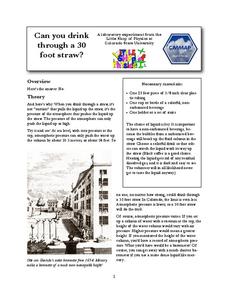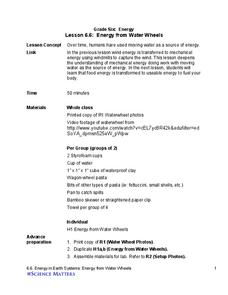Curated OER
Flight Physics
Students apply the knowledge of Bernoulli's Principle and construct simple aerodynamic designs. In this flight physics lesson, students explore the history of man's interest in flying and the forces influencing an object in flight by...
Curated OER
Physics 210: 24
In this physics 210 activity, students answer the question of the predicted modes of oscillations heard based on the information provided in the word problems. Students apply their understanding of sound waves to answer the questions given.
Curated OER
Chemical Reactions
For this chemical reactions worksheet, students compare endothermic and exothermic reactions, closed and open systems, and reactants and products. Students review physical and chemical changes and how to balance equations. This worksheet...
Curated OER
Physics and the Quantum Mechanical Model
For this physics worksheet, students review vocabulary terms and key equations associated with the quantum mechanical model. Students apply the quantum theory to explain the photoelectric effect. This worksheet has 5 true or false, 12...
Curated OER
Activity Three -- Rutherford's Discovery (Student Page ) A Lab Experiment in Physics
This discovery student page offers students an opportunity to work as a team to discover the shape of an object they cannot see. It is an experiment which parallels particle physicists dilemma in not being able to see very small...
Curated OER
Reflection and Refraction
What is a prism? A place for light waves that commit minor refractions! The thorough resource includes three hands-on investigations covering light reflection and refraction; mirrors, lenses, and images; and optical systems. Subject...
CK-12 Foundation
Sprinter
Why do sprinters wear spiked shoes? Scholars explore various styles of shoes and how they handle forces when running. Scholars adjust variables including shoe type, horizontal force, surface type, and normal force to determine which...
Physics Classroom
Match That Free-Body Diagram
Pupils read a description of a physical situation and select the free-body diagram that best matches. As part of a series on applying Newton's Laws of Motion, scholars reinforce their skills applying forces and considering their relative...
Science Matters
Peanut Energy
How do humans get energy since they aren't mechanical and can't photosynthesize? Learners explore this question by relating potential energy in food to human energy levels. Scholars measure the change in mass and a change in temperature...
Colorado State University
Can You Drink Through a 30 Foot Straw?
Drinking straws are a pretty simple device ... or, are they? Explore the possibility of sipping a beverage 30 feet away with an engaging activity that's sure to keep pupils guessing. Just place a long piece of plastic tubing in a glass,...
Science Matters
Energy from Water Wheels
Historians believe the first vertical water wheel was invented in Rome during the Augustan Age. The sixth lesson plan in the series of 10 has scholars experiment with designing their own water wheels. Through testing various pastas and...
Curated OER
Roller Coasters
Twisting and turning through the sky, roller coasters are popular attractions at amusement parks around the world, but how exactly do they work? Explore the physics behind these thrilling rides with an engineering design activity....
Science Companion
Simple Machines Design Project
Make your work as a teacher a little easier with a physical science project on simple machines. After introducing young scientists to these devices and identifying their different uses around the school, this project engages children in...
Virginia Department of Education
Planet Line-Ups
Should Pluto be considered a planet or a dwarf planet? Scholars research planets in our solar system to understand their similarities and differences. It also includes memory activities related to the order of the planets.
Curated OER
Oceanography Worksheet #1
If you are teaching physical oceanography to middle school earth scientists, here is a terrific multiple choice worksheet. Learners look at a diagram of a landscape created by glacial sediment deposition and the resulting ocean floor....
Curated OER
Backpacks and Hills
This machines PowerPoint reviews effort and force in relation to work and informs students about different types of machines and the different ways forces are applied and how they work to increase efficiency.
Curated OER
Blast Off
In this physical science exploration, small groups place a piece of antacid tablet into a film canister and step back to time how long it takes for the top to pop. They repeat the activity, altering either the amount or temperature of...
Curated OER
Physical and Chemical Changes
Eighth graders distinguish between physical and chemical change. For this chemistry lesson, 8th graders observe a series of demonstrations showing physical and chemical changes. They identify the signs that a chemical reaction took place.
Curated OER
What was Newton's Idea of Science?
Students form logical foundations for analysis of observations. They improve analytic reading abilities through practice. Students investigate the foundations of scientific thought processes and how to apply them.
Discovery Education
Sonar & Echolocation
A well-designed, comprehensive, and attractive slide show supports direct instruction on how sonar and echolocation work. Contained within the slides are links to interactive websites and instructions for using apps on a mobile device to...
Howard Hughes Medical Institute
Population Dynamics
Will human population growth always be exponential, or will we find a limiting factor we can't avoid? Young scientists learn about both exponential and logistic growth models in various animal populations. They use case studies to...
Curated OER
Catapult Physics
Student explore the relationship between Hooke's Law and catapults. After exploring the four types of catapults, students use Hooke's law to determine the spring constant in a torsion powered catapult. They answer questions based upon...
Curated OER
Science:Effects of Weathering
Seventh graders take an outdoor observation walk around the campus and take soil samples. Working in groups , they conduct experiments with rocks and soil that demonstrate the effects of different types of erosion.
Curated OER
The Physics of the Planets: How 16th and 17th Century Physicist Helped Us Understand Our Solar System
Eighth graders draw the paths of the planets in the solar system. In this astronomy lesson, 8th graders calculate speed of objects using distance and time information. They research about the work of scientists in the 16th and 17th century.

























